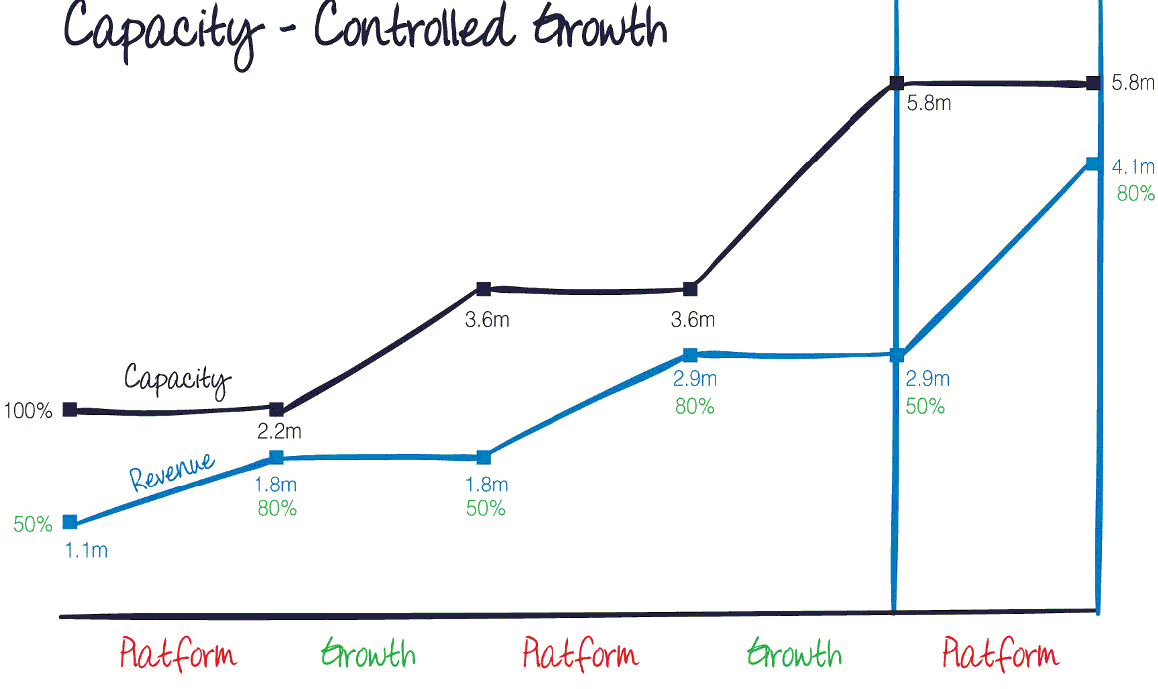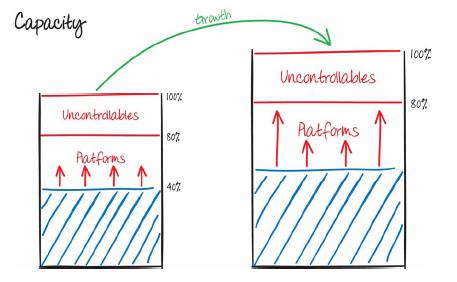
Why Growth is the Most Dangerous Word in Business
by Jacob Aldridge, International Business Advisor
What is the maximum amount of revenue your business could produce this month? It’s a serious question, and yet most businesses aren’t sure of the answer.
You probably know how much revenue or income you produced last month. You probably have a figure in mind for how much you want to produce. But if you’re like most businesses, you’ve never done the exercise to determine your current capacity to earn.
This is important because not knowing your capacity means you can’t be sure how efficient – or not – your business is at any time. It also means not being clear about how you are going to move from the business you have today into the business you want to lead (or sell) in the future.
Sure, you want to “grow”. But without understanding capacity, what does that even mean?

Why isn’t “Growth” a good business strategy?
Growth sounds like the ideal goal for every business and a focus for every key employee. So why is it the most dangerous word in business?
Because in practice, “Let’s Grow” is both too obvious to warrant debate and too vague to actually communicate a direction. Growth means different things to different people – and some of those things are mutually exclusive.
Think about it: do you want growth in revenue or profit? Product lines or headcount? Do you want personal growth as well, or is it all about growing business valuation?
It’s entirely possible for two managers in your business, working on growth, to be simultaneously recruiting (grow headcount) and shedding (grow profit) staff. In my experience advising privately-owned businesses around the world, a focus on “Growth” usually means a strategy that hasn’t been clearly defined and articulated.
You can’t plan the growth in your business if you don’t define what Growth actually means. And that brings us back to your current capacity to generate revenue.

Your Capacity Cups
Most business planning is top-down – you take last year’s figures and add 10%.
This sometimes means placing too high an expectation on an already super-efficient team. More often, however, it’s setting a target that is way too low – the business has the capacity to increase revenue by much, much more.
So how do you know? I like to think of every business as a Cup. Just like a cup has the Capacity to hold a maximum amount of water, your business has the Capacity to generate a maximum amount of revenue.
Capacity is not Revenue. It’s not your Budget. And it’s definitely not your Profit or Equity. It’s a measurement that sits above all of those, telling you how realistic (or pessimistic) those other figures may be.
Once you can calculate your Capacity, you can see at a glance how full your cup is, and how efficiently your business is operating.
So how full is your Cup today?
As a percentage, how full is your cup? 20%? 50%? 85%? I find business owners normally have a gut feeling about how efficiently their business is running (though staff tends to overestimate how busy they are).
You can also do this exercise in more detail, using hourly rates or project averages. Being able to calculate your Capacity – the size of your cup – and show your work is a great way to demonstrate to your team that they definitely have room to improve.
The target is not to run your business at 100% Capacity – nobody fills a cup to the brim and expects to be able to function. But the fuller your cup, the greater your profit and free cash flow, and the easier it is … to invest in a bigger cup.
The Only Strategic Choice
Of the million things, you could be doing in your business, using Capacity reduces your decision down to just one question: Right now, do you need to “Fill the Cup” (reduce those inefficiencies and create more revenue with the current resources) or do you need to “Grow the Cup” (increase resources to grow capacity)?
Now “Growth” has a specific definition – Growth incapacity. And by itself, it will lead to disaster, because owning an enormous – but almost empty – cup is not a good idea!
You can begin to see how this leads to a clearer strategic direction. Once you fill the current cup (though most of my clients grow faster by setting a target of 60%-80% full) you will need to grow into a bigger one. And once you have that bigger cup, you will need to fill it. And the growth cycle continues – fill the cup, grow the cup, fill the cup.
Actions
What do you mean by growth?
More revenue, more profit, more people, more products? All of the above? Would it be easier if you could separate strategies that “Grow the Cup” from those that focus on “Filling the Cup”?
Do your numbers
Gut feel is OK for a first draft, but be honest – how efficient are you really today?
Write down your capacity plan
What are you going to do to fill your current cup? How full do you want it to get? Then how will you build a bigger cup? And so on.
In next month’s article, we will discuss the 6 Ways to Fill the Cup and the 6 Ways to Grow the Cup. Make sure you (and your business partners) are subscribed to the KDM Newsletter!



